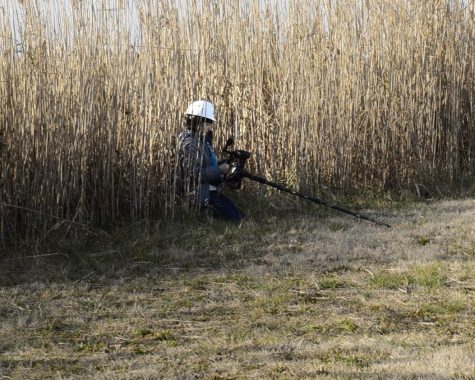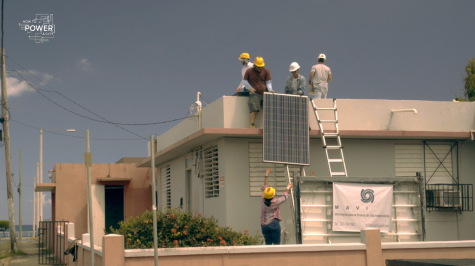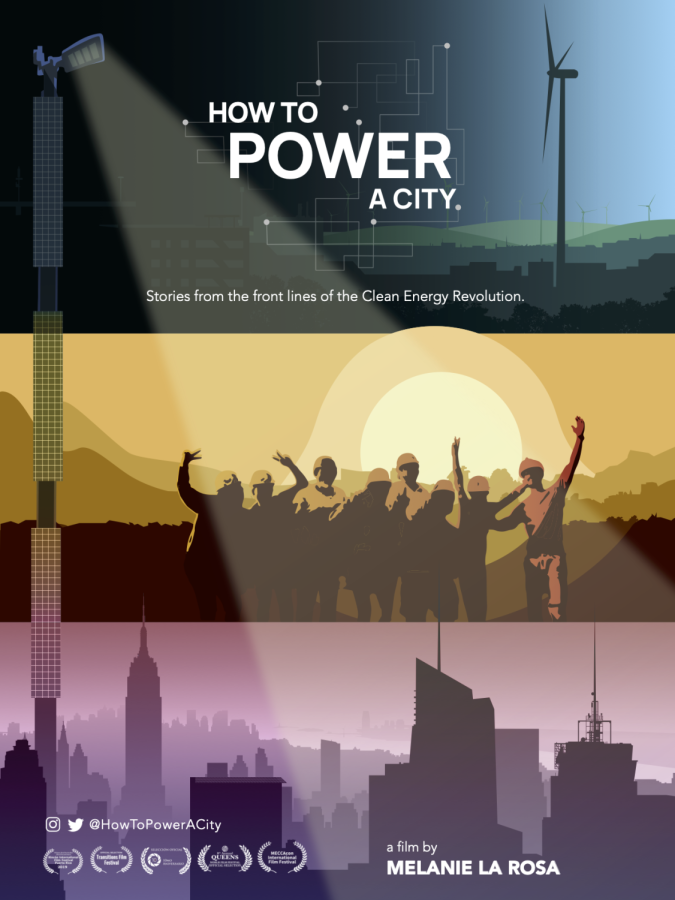Pace Professor to Release “How To Power A City” a Renewable Energy Documentary
It’s not every day that a Pace professor has a documentary they directed and created for release, but Professor Melanie LaRosa of the Media Communications and Visual Arts (MCVA) Department is currently working to market a film she has been working on since 2017.
This is not her first documentary; Professor LaRosa has produced, directed, and written two prior documentaries. The first one she made is titled “Sir: Just A Normal Guy,” released in 2001, and “The Poetry Deal: A Film With Diane Di Prima” released in 2011.
Her new documentary “How To Power A City” follows the stories of people in New York City, Puerto Rico, Vermont, Las Vegas, and Highland Park Michigan, who are using renewable energy with varying projects and goals, all in the face of fossil fuel-caused climate change.
On finding subjects for the story, LaRosa said, “I found people who are doing work in these locations who are leading projects, and just started calling and emailing. And we just, you know, every single place was a cold call, they weren’t anybody I knew before I started this film.
I think my criteria, first and foremost was […] it has to be a place that’s actually providing energy like now for something specific, even if it’s teeny tiny, but something specific.”
Throughout her work, she discovered that this is an access issue. One can only use renewable energy if you have a point of access. LaRosa shared the main theme of the documentary. How does one make their own personal contribution to offsetting climate change? How can one help the greater community with climate change-based issues?
LaRosa continued with this idea, saying, “It’s just hard to even understand how do I get started. Okay, so I want solar, great like I’m sitting here in a New York City apartment, but I just buy from the electric company. What am I supposed to do, right? So it was really to dig into that how, you know. […] So that’s kind of the main theme is how other people can do it based on how several different people chose to do it in their community.”

This 72-minute project is LaRosa’s vision entirely, but she did get help along the way from cinematographers, animators, story consultants, a composer, and even several students.
LaRosa has worked with many Pace students within the MCVA department as well as even students outside of the department over the years for this documentary.
This year, she worked with Kendall Key, a marketing student; Nathan Spano, an MCVA Digital Cinema and Filmmaking student; and Alisha Bhandari, also an MCVA Digital Cinema and Filmmaking student.
On her collaboration with professionals and students, she said. “You know, you start something, and people like the idea, and they really do come to you. Like I’ve really had a lot of people just kind of come my way right person right time. So whenever they say it’s like a one-person thing, yes, it is. But there’s so many other people that are involved, too.”
While finding money is always a challenge when it comes to making a documentary, LaRosa wrote several grant proposals, most of which were funded. The Solutions Journalism Network, a non-profit organization, was excited for her to apply for their $5,000 dollar grant. Her Indiegogo campaign paid for a lot of the filming in Puerto Rico and Detroit, and she also received two grants from the Puffin Foundation and Yip Harburg Foundation.
With the number of grants she received, funding proved to be less difficult than normal. “I’d be lying if I told you funding was the hardest because I’m not gonna say it was a fully funded film. But again, people who wanted to be a part of this project, they came out of the woodwork in a way.”
By far the most difficult issue with the documentary was something completely out of LaRosa’s control. After a car crashed into her bike in New York City, she was left unable to walk for three months. It was a huge setback for her, and not long after the pandemic went into full effect, putting a pause on production.
Despite such a serious accident, LaRosa was ready to get back to work when she could. “So there’s always that kind of stuff, you know, anyone who’s balancing a large creative project and has a major life incident happen to them has to find a way to keep going.”
LaRosa mentions the overall challenge with these kinds of creative projects is putting everything together in a way that captivates its audience. It’s a process that requires many hard decisions about what to include and what not to.
“Creatively, the real hard part of these stories, they’re all very compelling on their own, but is finding a way to weave them into a cohesive feature […] because inevitably, you have to drop some things, in order for it all to make sense.”
For a film to succeed, you need to figure out how it resonates with audiences, which is why LaRosa has held sneak preview screenings.

She was able to set one up with Solar United Neighbors, a national organization of people who advocates for more people to go solar in the fight for energy rights. This is an important audience because they have an established connection to energy, and appreciate the film for that.
In addition to film festivals and standard screenings, LaRosa is searching for more organizations that have that same kind of connection. “I’m looking to connect with more organizations like that, that are people who are just natural audiences who really want this kind of story.” With this, she is able to find out if what she made really works.
LaRosa started the development process of the film from 2011 to 2017, conducting research and figuring out what she really wanted to do. The vast majority of the film was shot in 2017 and 2018, and with the setback from the pandemic was able to finish it in the current year of 2023.
Creating this kind of project is an extremely long process, but LaRosa believes that the more time you spend on a project, the longer it will last. She makes a connection to Everything Everywhere All at Once, a film that had a production time of 12 years but was able to win a lot of Oscars because of the amount of time and dedication put into it.
“The stuff you turn out fast, it’s like a match, like you strike it once it goes out right? We do the long burn, the slow burn, like it might take a long time but it’s also gonna last a long time, and that’s really important if you’re trying to sell it or just screen it and reach all the audiences and for it to really have the kind of impact helping the world in a different way.” It was important to LaRosa that this film stays relevant for a long time, much like books that were written 10 or 50 years ago and are still relevant to the world we currently live in.
“How To Power A City” does not yet have a release date, but a trailer is available online. Further information can be found on the website www.powercityfilm.com or on their Instagram, @howtopoweracity.
Your donation supports independent, student-run journalism at Pace University. Support the Pace Chronicle to help cover publishing costs.

